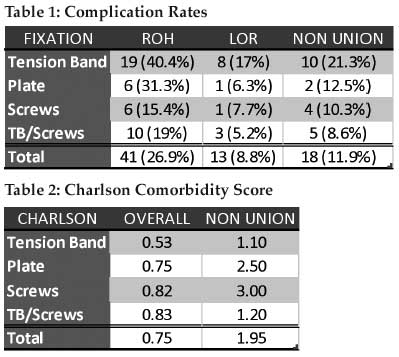
Sat., 10/15/11 Recon, UE, Wrist & Hand, Paper #87, 4:10 pm OTA-2011
Determining the Efficacy of Screw and Washer Fixation as a Method for Securing an Olecranon Osteotomy Following the Treatment of Intra-Articular Distal Humerus Fractures
Barrett I. Woods, MD; Andrew R. Evans, MD; Robert Hartman, MD; Peter Siska, MD;
Gary S. Gruen, MD; Ivan S. Tarkin, MD;
Dept. of Orthopaedic Surgery, Division of Traumatology, University of Pittsburgh
Medical Center, Pittsburgh, Pennsylvania, USA
Purpose: Utilization of a transolecranon exposure for the reduction and fixation of complex distal humerus fractures significantly improves visualization of the articular surface. However, complications following olecranon osteotomy have resulted in some controversy as to what is the optimal method of fixation. The use of screw and washer fixation alone has been called into question as an effective method of securing an olecranon osteotomy. Thus the purpose of this study was to critically evaluate the efficacy of screw and washer fixation in comparison to other methods for securing an olecranon osteotomy. The hypothesis is that screw and washer fixation is a safe and effective means of olecranon osteotomy fixation with fusion and complication rates similar to other currently utilized methods of fixation.
Methods: We retrospectively reviewed all patients at our institution over the past 20 years with type C3 comminuted intra-articular distal humerus fractures who required open reduction and internal fixation and received an olecranon osteotomy. Included patients received 1 of 4 types of fixation (screw, tension band, tension band and screw, plate) following osteotomy. The primary outcome measure was the presence of osteotomy union. Secondary outcome measures were olecranon nonunion, loss of articular reduction (LOR), and removal of hardware (ROH). Comorbidities were stratified using the Charlson comorbidity index.
Results: A total of 187 patients were identified of whom 160 met inclusion criteria. Of the 160 patients 39 had screw fixation, 47 had tension band fixation, 16 had plate fixation, and 58 had tension band and screw fixation. There was no significant difference in olecranon fusion rates between screw (89.7%), plate (87.5%), or tension band and screw (91.4%) fixation. Tension band fixation alone had a significantly lower osteotomy fusion rate (78.7%) in comparison to the other methods of fixation (P < 0.05).
Table 1 illustrates complications rates with each type of fixation. Tension band fixation had significantly higher complication rates for each outcome measure compared to other types of fixation (P < 0.05).

Table 2 illustrates the Charlson comorbidity score. For the patients who developed nonunion, the Charlson score on average was higher in comparison to patients who healed their osteotomy.
Conclusions: Screw and washer fixation appears to be a safe and effective means of securing an olecranon osteotomy, with fusion and complications rates similar to other methods of fixation. Tension band fixation had a significantly lower fusion rate and higher complication rate compared to the other studied methods of fixation. Charlson score appears to be one factor that may influence the development of nonunion following osteotomy.
Alphabetical Disclosure Listing (628K PDF)
• The FDA has not cleared this drug and/or medical device for the use described in this presentation (i.e., the drug or medical device is being discussed for an “off label” use). ◆FDA information not available at time of printing. Δ OTA Grant.